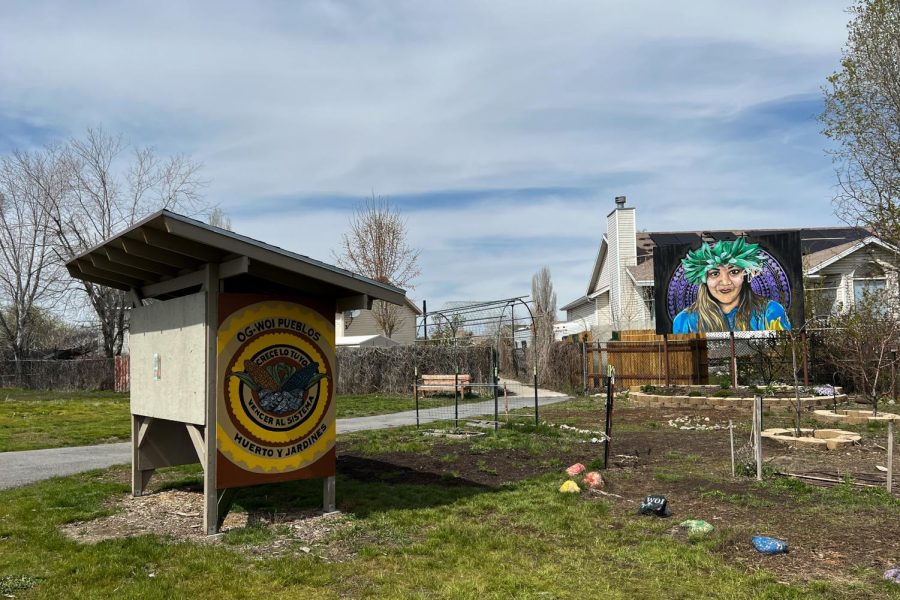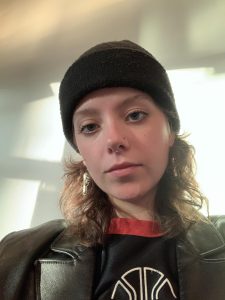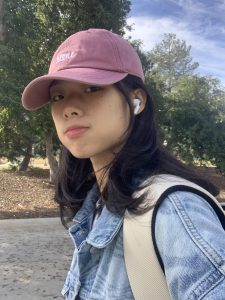Jarvis: The Og-woi People’s Orchard and Garden is for Healing
Og-Woi People’s Orchard & Garden in Salt Lake City on April 23, 2023. (Photo by Julia Chuang | The Daily Utah Chronicle)
May 22, 2023
By resisting commodification, gardening becomes an effective form of protest. And if gardening is a form of protest, guerilla gardening is even more so. Salt Lake City’s Og-woi People’s Orchard and Garden practices guerilla gardening — a form of gardening in which the gardeners do not have legal rights to cultivate the land.
Guerilla gardening and community gardens are valuable, providing access to food and helping the environment by reducing waste and air pollution. Plants absorb rainwater, diminishing the number of pollutants that run into rivers, lakes and streams. They can also instill a sense of belonging with one’s community. I felt this sense of belonging as I planted ornamental kale and pansies with volunteers at Og-woi on Earth Day. However, the city is attempting to remove the Og-woi.
Though people can’t legally garden just anywhere, Salt Lake City should recognize the role guerilla gardening plays here.
Og-woi’s Roots
Guerilla gardeners often cultivate abandoned or otherwise unused public land. Gardening of this type commonly attempts to beautify these spaces. Guerilla gardens can also serve as community gathering places that feed the public while promoting environmental sustainability.
The Og-woi is a local example of this. Located near the Jordan River in West Salt Lake City, the original collective began the garden in 2020, planting six small trees on abandoned land. It has since grown, now including flowers, vegetables, murals and a community bulletin board. The entire project is maintained by volunteers who teach people to grow their own food, giving away thousands of seedlings for free every year.
Dee Platero, a volunteer at Og-woi, heard about the garden and realized they could plant a MMIW — Missing and Murdered Indigenous Woman and Girls — garden. The idea was to share produce with families who had lost a loved one in the MMIW epidemic. Platero explained the medicinal aspects of Og-woi plants such as sweetgrass, tobacco, sage and cedar for smudging, an Indigenous healing ritual.
I also spoke with Maile Arvin, the Director of the Pacific Island Studies program at the U and a volunteer for the Og-woi. She highlighted the importance of the garden for Pacific Islanders, in part because of the garden’s mural of Margarita Satini, late community leader and activist. “To have the mural is just so joyful and embodies a lot of the warmth that Margarita always brought to a space,” Arvin said.
The Og-woi Garden facilitates healing through guerilla gardening. “I think it’s interesting to see this kind of phenomenon happen where people feel more empowered to say, I don’t like how this land is,” Platero said. “Why did it take the community and an act of civil disobedience to improve it?”
Protect the Og-woi
Though garden volunteers have been communicating with the city, last year, the city stopped responding. The Og-woi received a letter in late March ordering garden volunteers to remove the garden infrastructure by May 1. But Mayor Erin Mendenhall told volunteers in a later email that she wants the space to be repaired, not closed or destroyed. Mendenhall’s concerns focused on contaminated soil at the site.
Arvin explained that this seems like a miscommunication between the garden and the city. Some volunteers built raised garden beds and brought in new soil to avoid any contamination. Many garden volunteers agree with the mayor’s concerns, but the city isn’t aware of actions the garden has taken. “And if the city has other kinds of requirements, they just haven’t been communicated very effectively,” Arvin said.
Guerrilla gardening also resists the notion that land is owned by government. Some defend the Og-woi as part of the Land Back movement, which works to return control over land to Indigenous people. A recurring theme in public comments for the Og-woi is that its land was stolen from Indigenous people. Therefore, this garden has every right to be there. In fact, “Og-woi” means river in the Shoshone language, as shown on signs at the garden.
Others believe the garden needs to go because it attracts homeless groups. But the Og-woi People’s Orchard and Garden serves the community and should benefit all its members, including unsheltered ones.
The forced eviction of the Og-woi mirrors the city’s procedure of tearing down camps where unsheltered people live. Fort Pioneer, where a few hundred people lived for months, was a successful encampment before officials demolished it. Meanwhile, the people living there protested and wept. Fort Pioneer’s unofficial mayor, Stacey Johnson, said that Mayor Mendenhall had lied to her about ensuring the camp’s protection.
It might be hard to trust Mendenhall’s claims after this. We can’t guarantee that she doesn’t intend to destroy the garden, so we must speak up in its defense.
Authorities must have more compassion and understanding. The city must also protect the Og-woi and better communicate with its volunteers. Community gardens, including those that began as guerilla gardens, help heal communities. The Og-woi land is getting cared for and beautified while benefiting as many people as it can reach.









